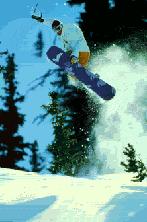So, you've decided to take the plunge and buy your own
board. You want the best that you can afford, but there seem to be more designs
out there than there are snowboarders. Flex, sidecut, core construction, never
mind graphics - how on earth do you decide?
Freestyle
If trick riding and catching air a re your thing and you're
planning on spending most of your time hanging out in the halfpipe and the
terrain park then a freestyle board will fit the bill. A typical freestyle board
will be relatively short, and lightweight, making it easy to launch huge air out
of the pipe or off kickers, and to switch stance (forward and backward). The
design of freestyle boards is still changing from year to year, with the classic
directional shape currently back in favour after a period when the twin tip
design was more popular.
re your thing and you're
planning on spending most of your time hanging out in the halfpipe and the
terrain park then a freestyle board will fit the bill. A typical freestyle board
will be relatively short, and lightweight, making it easy to launch huge air out
of the pipe or off kickers, and to switch stance (forward and backward). The
design of freestyle boards is still changing from year to year, with the classic
directional shape currently back in favour after a period when the twin tip
design was more popular.

Freeride
If you want to cruise the whole mountain, hitting the
powder at every opportunity, taking in all kinds of terrain on and off piste and
getting the odd air here or there a versatile freeride board might be for you.
If you want to ride powder, you'll want to choose a longer board for better
flotation.

Freecarving
Freecarving boards are typically stiffer and narrower than
freeriding boards, and are ideally suited to carving out long flowing turns on
piste and hardpack.

Racing
Racing (or alpine) snowboards are longer (over 180
cm) and thinner (less than 19 cm) than other snowboards and are for the serious
speed freaks only, so probably aren't the best choice for a first board, unless
you've got Olympic ambitions. They're also much stiffer, and have significantly
less sidecut in the tail to keep the board pointing down the fall-line after
turning.
Unlike freestyle, freeride and freecarve boards, which are
ridden with soft boots and strap or step-in bindings, racing boards use a plate
binding system and hard boots.

Sex and Age
Boards designed specifically with the requirements of
female and younger riders are also available. Female riders are typically
lighter and have smaller feet, so lightweight, softer-flexing boards, in slimmer
widths.fit the bill. Children's boards, as well as being smaller, often
incorporate a very soft flex pattern (from a thin core) that makes turning and
stopping easier.

Length, Width & Flex
Once you've made the basic decision about which kind
of board you're looking for, you'll need to narrow your choice down to specific
models. Shop staff can often offer good advice here, but you'll need to be aware
of and honest about your skill level and your goals if you want to get the best
advice - because if you aren't, only you will suffer.
Snowboards turn, in part, by bending, so for lighter
riders, and for beginners, a softer, more flexible board will be less twitchy
and easier to handle, particularly in deep snow. Conversely a stiff board will
be the best for holding on edge hard/packed snow, but will be harder to handle.
As a general guideline, the better a technical rider you are the stiffer the
board you will be able to handle, though that is not to say of course that all
good riders should ride stiff boards.
Having decided on which type and stiffness of board, you
still need to settle on a length, width and sidecut. When it comes down to
selecting the length of your board, your weight is the deciding factor - the
more you weigh the longer your board will need to be.
Board width is another important feature - too narrow
and your toes and heels will hang over the edge of the board and dig into the
snow when you try to turn; too wide and you will find it more difficult to
initiate a turn and hold an edge. Aim for between 1cm and 1.5 cm of overhang at
both toe and heel. Choice of width is particularly important if you have big
feet. The ideal width will also depend upon the type of riding you want to do -
a narrower board will be quicker edge to edge, whereas a wider board offers good
flotation and will be easier to land jumps on.
The sidecut of the board will determine the type of
turns the board will make. A deeper sidecut means shorter, more precise turns -
ideal for halfpipe and racing use. Sidecut is probably less critical if tricks
or off-piste riding are more your scene.
When all's said and done, though, you've just got to
go for the board with the best graphics!
Ideally, you'll be able to try out your choice on the
mountain before you part with your money. Lots of shops let you "demo"
the boards before you make your choice. They should and will refund a demo fee
if you subsequently make a purchase.
